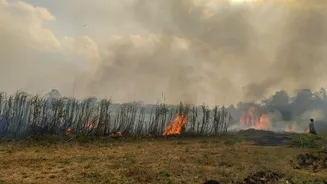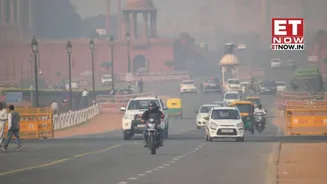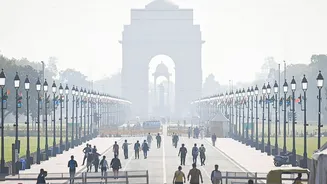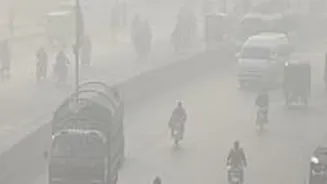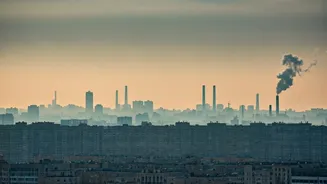What is the story about?
Winter is coming, and so is the pollution! Over the last few years, winters in Delhi have come to be synonymous with high pollution levels.
Though stubble burning in Punjab, Haryana, and Uttar Pradesh is a significant contributor to
Delhi's air pollution, vehicular emissions, construction dust, industrial activities, and domestic biomass burning are also among the major reasons.
Data from multiple scientific studies show a more nuanced reality. Stubble burning is a major factor that can significantly escalate pollution for short periods during the post-monsoon season, but remains one of several key contributors.
According to a study published earlier this year, the crop residue burning in Punjab and Haryana only contributes about 14% of PM2.5, The Hindu reported.
The study, published in the journal Climate and Atmospheric Science, found that the concentration of PM2.5 in Delhi-NCR remained relatively consistent and constant, although stubble-burning events in Punjab and Haryana decreased by more than 50% between 2015 and 2023.
According to a PTI report dated November 25, 2024, the number of stubble-burning events measured by ISRO fell sharply year on year in Punjab and Haryana between September 15 and November 18 — from 48,489 in 2022 to 33,719 in 2023 and 9,655 in 2024 in Punjab, and from 3,380 in 2022 to 2,052 in 2023 and 1,118 in 2024.
In an email to The Hindu, Dr Prabir K Patra from the Research Institute for Humanity and Nature (RIHN), Kyoto, Japan, and one of the corresponding authors, stated, “There is no linearity between fire counts in Punjab/Haryana andPM2.5 variations [in Delhi-NCR].”
Dr Poonam Mangaraj from RIHN, Kyoto, Japan, and the first author of the paper, said, "While the wind patterns play a crucial role in pollutant transport, they are not the sole factor determining PM2.5 levels. Other meteorological factors and local emissions also influence the PM2.5 levels significantly."
Dr Sachchida N Tripathi of IIT Kanpur, who was not involved in the study, noted that the transport sector is the largest contributor to fine particulate matter at 30%, followed by local biomass burning at 23%, the construction industry and road dust at 10%, cooking and industry at 5-7%, and the remaining 10% unaccounted for.
In contrast, stubble burning in Punjab and Haryana contributes only about 13%, and that too only during October and November.
Though stubble burning in Punjab, Haryana, and Uttar Pradesh is a significant contributor to
Data from multiple scientific studies show a more nuanced reality. Stubble burning is a major factor that can significantly escalate pollution for short periods during the post-monsoon season, but remains one of several key contributors.
According to a study published earlier this year, the crop residue burning in Punjab and Haryana only contributes about 14% of PM2.5, The Hindu reported.
The study, published in the journal Climate and Atmospheric Science, found that the concentration of PM2.5 in Delhi-NCR remained relatively consistent and constant, although stubble-burning events in Punjab and Haryana decreased by more than 50% between 2015 and 2023.
According to a PTI report dated November 25, 2024, the number of stubble-burning events measured by ISRO fell sharply year on year in Punjab and Haryana between September 15 and November 18 — from 48,489 in 2022 to 33,719 in 2023 and 9,655 in 2024 in Punjab, and from 3,380 in 2022 to 2,052 in 2023 and 1,118 in 2024.
In an email to The Hindu, Dr Prabir K Patra from the Research Institute for Humanity and Nature (RIHN), Kyoto, Japan, and one of the corresponding authors, stated, “There is no linearity between fire counts in Punjab/Haryana andPM2.5 variations [in Delhi-NCR].”
Dr Poonam Mangaraj from RIHN, Kyoto, Japan, and the first author of the paper, said, "While the wind patterns play a crucial role in pollutant transport, they are not the sole factor determining PM2.5 levels. Other meteorological factors and local emissions also influence the PM2.5 levels significantly."
Dr Sachchida N Tripathi of IIT Kanpur, who was not involved in the study, noted that the transport sector is the largest contributor to fine particulate matter at 30%, followed by local biomass burning at 23%, the construction industry and road dust at 10%, cooking and industry at 5-7%, and the remaining 10% unaccounted for.
In contrast, stubble burning in Punjab and Haryana contributes only about 13%, and that too only during October and November.
Do you find this article useful?
